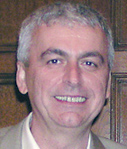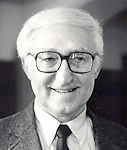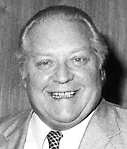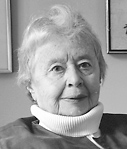Traianos Gagos
Traianos Gagos, professor of papyrology and Greek in the Department of Classical Studies and archivist at Hatcher Library, died suddenly April 26. He was 49.
Gagos came to U-M in 1987 with his doctorate from the University of Durham, England, as visiting assistant research scientist to proofread the papyrus texts that a team of papyrologists at Duke University had fed into an Ibycus computer. In 1991 he was appointed associate archivist, in charge of the papyrus collection. U-M has the largest and most important collection of these documents and literary texts from the ancient world in this hemisphere.

Photo courtesy Department of Classical Studies.
At the same time, he began teaching modern Greek for the Department of Classical Studies. Largely thanks to years of his work in fundraising and outreach, LSA was able to create the position of chair of modern Greek literature in the Department of Classical Studies and to provide a full curriculum in modern Greek language, literature and culture. Without Gagos, his success in teaching and his connections to the Greek community, this never could have happened, colleagues say.
He came to U-M to be a papyrologist, however, not a modern Greek instructor. In 1995 he became assistant professor of papyrology and Greek. The first job of a papyrologist is to decipher and interpret these difficult, fragmentary bits of antiquity, and he did that with extraordinary skill, colleagues say. At the same time, he also labored to make U-M’s collection more accessible to both scholars and a broader public. From 2000-08 he was the director of the APIS project, which has made papyri available digitally. This was underscored when the American Society of Papyrologists asked him to edit its official periodical (2000-06). In 2002 he was elected president of the American Society of Papyrologists for three years. In 2007 he brought the triennial International Congress of Papyrology to Ann Arbor, marking Michigan’s leadership in the field.
Throughout his career, he was a connector. As a librarian, he made the collection more useful to scholars while making translations available online along with the texts, so that nonspecialists could see them and learn from them. He regularly gave enthusiastic tours of the collection to schoolchildren as well as to other visitors. He closely collaborated with the Kelsey Museum and with the Department of Near Eastern Studies. This collaboration became important for Gagos’ teaching of graduate and undergraduate students as well as for research, because he appreciated that the papyri needed to be understood in their archaeological context and that Greco-Roman Egypt was a complex and multicultural culture.
Colleagues say he was a superb graduate and undergraduate teacher, whether he was introducing advanced undergraduates to papyrological research, serving on dissertation committees in ancient history or teaching second-year ancient Greek. He also was a man of intense friendship, laughter, song and dance. His joy in life was contagious, friends say.
He is survived by his wife, Gina Soter. — Submitted by Ruth Scodel and Ludwig Koenen, Department of Classical Studies
Dr. Joseph E. Johnson III
Dr. Joseph E. Johnson III, former dean of the Medical School, professor of internal medicine, physician and scholar, died April 19 in Jacksonville, Fla. He was 79.

Photo courtesy Medical School.
During his tenure as dean (1985-90), the Medical School significantly expanded its clinical and research capabilities and capacity, and began planning a major revision of its medical education curriculum.
“Dean Johnson led the U-M Medical School through a period of rapid expansion in both reach and impact,” says Dr. James Woolliscroft, the current dean. “Dr. Johnson was well regarded for his infectious disease expertise and his leadership of this institution through a period of great change.”
Johnson was born on September 17, 1930, in Elberton, Ga., where he spent his early years. He earned his Bachelor of Arts and medical degrees from Vanderbilt University in 1951 and 1954, respectively. He completed both his internal medicine residency and a fellowship in infectious diseases and immunology at Johns Hopkins Hospital.
In 1966 Johnson joined the medical school faculty of the University of Florida as the division chief of infection diseases and he also served as assistant dean. In 1971 he was named chairman of medicine at the Wake Forest University Bowman Gray School of Medicine.
Johnson came to U-M as dean in 1985.
While dean, Johnson recruited eight department chairs and established 11 endowed or collegiate chairs. The new University Hospital and A. Alfred Taubman Health Center opened their doors in 1986. Three multidisciplinary “Centers of Excellence” were designated by the Board of Regents in the fields of cancer, geriatrics and substance abuse.
External funding for research more than doubled during this period. Two new research buildings were activated during Johnson’s tenure: Medical Science Research Building I in 1986 and Medical Science Research Building II in 1989. In addition, planning began for cancer and geriatrics facilities as well as a third Medical Science Research Building.
During this time, medical education was changing across the nation and U-M began planning a major revision of its medical education curriculum. These plans included placing more emphasis on preventive care, enhancing teaching in ambulatory care and importantly, fostering habits of critical thought and independent learning.
After completing his term as dean, Johnson remained a member of the U-M faculty until 1993.
His advocacy for excellence in medical education and clinical practice as well as his extensive knowledge of policy led to several leadership positions with the American College of Physicians. Upon his retirement in 2003, the ACP recognized his service by establishing the Joseph E. Johnson Leadership Award to recognize young physicians who demonstrate qualities that foster excellence and professionalism in the practice of medicine.
Johnson was the author of more than 100 scholarly articles, wrote numerous chapters in medical text books and edited three books. He received numerous accolades and awards throughout his career.
He enjoyed traveling with his wife, children and grandsons. He was an avid student and reader of history as well as a great music lover.
Johnson’s wife Judith Kemp Johnson died in 2004. He is survived by his sister, two daughters, a son and three grandsons.
For those interested, the family suggests donations be made to the Joseph E. Johnson III, M.D., Memorial Fund, Elbert Memorial Hospital Foundation, 4 Medical Drive, Elberton, Ga., 30635 or to the ACP/Joseph E. Johnson Fund, American College of Physicians, 190 N. Independence Mall West, Philadelphia, Pa., 19106-1572. — Submitted by Andree Joyaux, U-M Health System
Aksel Wiin-Nielsen
Professor Aksel Wiin-Nielsen, recruited to U-M from the National Center for Atmospheric Research in 1963 to become the first chair of the Department of Meteorology and Oceanography, died April 26.
Under Wiin-Nielsen’s chairmanship, the department became very strong in atmospheric dynamics, colleagues say.

Photo courtesy Tamas Gombosi.
In 1974 Wiin-Nielsen left U-M to return to Europe as the first director of the European Centre for Medium-Range Weather Forecasts (ECMWF). In 1980 he became the secretary-general of the U.N. World Meteorology Organization. From 1984-87 he was the director of the Danish Meteorological Institute, and in 1988 moved to the University of Copenhagen, where he retired in 1994. In 1988 he returned to the University of Michigan for a year as a visiting professor.
Wiin-Nielsen was president of the International Commission for Dynamic Meteorology, 1971-79; a member of the joint organizing committee of the Global Atmospheric Research Program, 1973-79; chair of the European Space Agency working group on Earth Sciences and Science Advisory committee, 1977-79; president of the ECMWF, 1986-87; and, from 1990-92, he was the chair of the NATO panel on the Science of Global Environmental Changes.
In 1998 he was honored with the most prestigious award conferred by the European Geophysical Society, when they elected him as an honorary member. He also was elected a fellow of the American Meteorological Society, and was a member of the American Geophysical Union, Swedish Academy of Sciences, Royal Meteorological Society, Finnish Academy of Arts and Sciences, Danish Academy of Technical Sciences, Royal Danish Sciences, New York Academy of Sciences and Tau Beta Pi.
He was widely known for his global approach to the study of the atmosphere and climate. Wiin-Nielsen was recognized worldwide for his exceptional contributions to geophysical research encompassing the entire field of dynamic meteorology with respect to observation, modeling and theory; his notable contributions to meteorological education by his many books and educational programs; and his important contributions in making the findings of scientific research accessible to the educated public and to build bridges to the general culture. — Submitted by Tamas Gombosi, Department of Atmospheric, Oceanic and Space Sciences
Patricia O’Connor
Patricia O’Connor, a faculty member who taught dental students, died April 14 in Ann Arbor.
O’Connor was an associate professor of dentistry in the Department of Educational Resources, where she taught both dental and dental hygiene students and contributed significantly to innovations in clinical teaching. She retired in 1988.

Photo by Pamela Guenzel.
A long term resident of Ann Arbor, she was born in Boston, Mass., graduated from Radcliff College with an A.B. degree magna cum laude, and earned a doctorate in personality psychology from U-M in 1959. Her major research centered on achievement motivation, curiosity and theories of teaching and learning.
Along with LiAnne Mercer, she co-authored a widely used textbook in nursing education called “Fundamental Skills in the Nurse-Patient Relationship” (W.B.Saunders Company 1969, 1974).
O’Connor had many gifts — of analytic thought, moral discernment, love of art — but her greatest gift was for friendship, colleagues say.
A memorial celebrating her life is planned from 2-4 p.m. June 12 at the Michigan League (Michigan Room). — Submitted by Christine Black, Medical School

